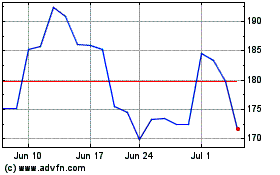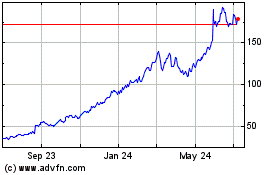CORRECT:UPDATE:Retailers Post Mixed Results;Promotions Lift Sales
July 08 2010 - 11:35AM
Dow Jones News
U.S. retailers reported mixed results for June, with some stores
benefiting from aggressive promotions and others hurt by consumers'
continued restrained spending.
Retailers from department stores to teen retailers responded to
limited demand with promotions that were reminiscent of 2009's
holiday season. Big sales during June are common as retailers try
to clear shelves for fall merchandise, especially back-to-school
apparel. But a number of analysts are calling June's discounting
steep.
"Many retailers pulled out all of the stops with respect to
promos in June," said Brian Sozzi, retail analyst at Wall Street
Strategies. "During our store walks throughout the month, the level
of promotions picked up relative to previous months."
Retailers that surpassed analysts' expectations were mostly
quiet about increasing their second-quarter guidance, raising
questions about whether the promotions, while aiding sales, came at
the cost of lower income for the items.
The retailers that are doing best amid what was a very
promotional atmosphere "have learned to carry fewer styles and less
units per size," said Madison Riley, managing director at Kurt
Salmon Associates. "This helps minimize markdowns and helps improve
profits."
One of the biggest surprises were the strong numbers from
Abercrombie & Fitch Co. (ANF), where same-store sales rose 9%,
above analysts' average estimate of 2.8%. Abercrombie was
aggressive with its promotions last month, including selling shorts
at half-price at its Hollister chain.
TJX Cos. (TJX) and Ross Stores Inc. (ROST), meanwhile, boosted
their fiscal second-quarter earnings expectations as the discount
apparel retailers reported further same-store-sales growth.
Elsewhere, Macy's Inc. (M) posted a 6.5% rise, when a 6.1% gain
was expected. The department store didn't lift its guidance but
added that it was "optimistic as we look ahead to our fall
merchandise offerings," Chief Executive Terry Lundgren said.
Same-store sales at J.C. Penney Co. (JCP) rose 4.5%, better than
the expected 3.4% gain, and the department store called out apparel
as showing "stronger underlying trends" during the month.
Geographically, all regions recorded same-store sales increases,
with the southeast region reporting the best results, Penney
said.
Apparel retailer Limited (LTD) and teen store Zumiez (ZUMZ) also
gave stronger-than-expected results.
Kohl's Corp. (KSS), meanwhile, came up short of analysts'
projections, posting a 5.9% rise when 6.5% was expected. "As
expected, we reported stronger sales early in the month as the
Memorial Day holiday fell in fiscal June this year," Chief
Executive Kevin Mansell said.
Mass merchant Target Corp. (TGT) also failed to see much
momentum, posting a 1.7% gain when analysts expected a 2.7%
advance.
"Sales in electronics, video games, music and movies were
particularly soft for the month," said Target Chief Executive Gregg
Steinhafel. "We continue to plan our business cautiously." Target
said it expects July same-store sales to be up in the low single
digits.
Costco Wholesale Corp. (COST)--which said same-store sales grew
4% in June, below the average analyst estimate of 4.2%--explained
that sales were helped by inflation in gas prices and strengthening
foreign currencies; however, the company also noted that the shift
in Memorial Day hurt sales by about 2%.
Wet Seal Inc.'s (WTSLA) June sales dropped 3.6%, below
projections, and the teen retailer said it sees second-quarter
earnings below its prior guidance. Customer traffic was
"inconsistent," the company said.
Retailers were expected to report 3.2% growth at stores open at
least a year, according to the 28 companies tracked by Thomson
Reuters. The estimate compares with a 4.9% drop last year.
Same-store sales are considered a key barometer of retailers'
health because the figures allow clean comparisons as opposed to
overall sales because store numbers fluctuate.
The nation's largest retailer, Wal-Mart Stores Inc. (WMT), no
longer reports monthly sales.
"We're almost treading water compared to the building spending
momentum we saw at the beginning of the year," said Mike Berry,
director of industry research at MasterCard Inc.'s Spending Pulse
unit. "At the beginning of the year, people were anticipating good
news and spending increased. When economy didn't turn around,
consumers took a step back."
The U.S. economy shed jobs in June for the first time this year,
and the unemployment rate remained high, while consumer confidence
dropped sharply.
-By Karen Talley, Dow Jones Newswires; 212-416-2196;
karen.talley@dowjones.com
Abercrombie and Fitch (NYSE:ANF)
Historical Stock Chart
From May 2024 to Jun 2024

Abercrombie and Fitch (NYSE:ANF)
Historical Stock Chart
From Jun 2023 to Jun 2024
